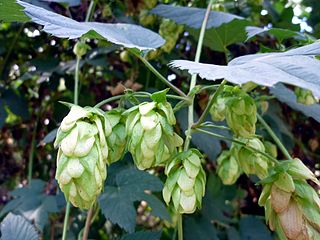
The fight to save honeybees has gotten boosts recently from the USDA, the White House, and researchers who are still working to determine why managed honeybees continue to die off. Now, bees have one more thing on their side: beer.

Or, at least, one of the main ingredients of beer. This week, the EPA approved the use of potassium salts of hops beta acids (HBAs) — a biochemical (or naturally-occurring) pesticide that’s derived from hops, the flowers of the plant Humulus lupulus — around honeycombs. Research has shown that HBAs have potential for repelling varroa mites, a dangerous mite that attaches itself to honeybees and sucks out their circulatory fluid. Varroa mites weaken bees and spread debilitating diseases, including deformed wing virus, which causes crumpled up, useless wings in young bees.
One 2012 study found that, when bees were wiped with solutions of 1 percent HBA, 100 percent of mites placed on them died, while the bees’ mortality was unaffected. It also found that, when cardboard strips dipped in HBA were placed in bee colonies, it caused more mites to fall off the bees than in colonies without HBA cardboard.
HBAs have long been used in beer brewing and as a preservative for meat, and because of this “long history of exposure,” they’re generally thought to be safe, according to the EPA. Beekeepers have been known to use other natural ways to try to get varroa mites off their bees: brushing bees with powdered sugar, for instance, increases their grooming activity, which dislodges the mites. Beekeepers can also use fumigants to try to rid the hive of mites, but that method can also result in bee deaths, making it a less-than-ideal solution.
Managed honeybees are still struggling in the United States, both from varroa mites and from other factors that scientists are still working to understand. A May survey found that U.S. beekeepers lost an average of 42.1 percent of their hives from April 2014 to April 2015, with beekeepers in some states seeing losses as high as 62 percent. These losses are bad news for beekeepers, who generally view losses of around 18.7 percent to be the maximum they can sustain and still be economically viable. In addition, this year, summer losses in bees were higher than winter losses for the first time — a finding that’s troubling to bee experts, who say bees are typically healthier in the summer, when flowers are blooming.
Varroa mites are likely contributing to winter losses, and poor nutrition — from bees getting all their food from crops instead of from meadows with a wide array of flowers — could be contributing to summer losses. Pesticides — especially one particular class, neonicotinoids — have also been pointed to as a potential cause of bee losses: neonicotinoids are used widely in agriculture and have been found to damage bees’ brains.